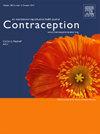当州政策与舆论发生冲突时:多布斯事件后俄亥俄州妇女对堕胎的支持率上升
IF 2.3
2区 医学
Q1 OBSTETRICS & GYNECOLOGY
引用次数: 0
摘要
目标多布斯诉杰克逊妇女健康组织案的裁决赋予各州更多的权力来管理堕胎护理。在多布斯案判决后的 12 周内,尽管俄亥俄州公众支持堕胎,但该州还是颁布了为期六周的堕胎禁令。我们评估了俄亥俄州妇女在多布斯案后对堕胎支持的变化,该州是一个限制堕胎的州,最近通过了一项旨在保护堕胎者获得堕胎护理的投票倡议。NORC 收集了 2018 年 10 月至 2019 年 6 月(多布斯之前)和 2022 年 9 月至 2023 年 8 月(多布斯之后)的数据。我们使用四种测量方法来评估堕胎态度:是否有人应该因堕胎而被捕、是否应该提供堕胎、堕胎是否可以接受以及支持生命/支持选择的身份。我们创建了一个量表,将这些指标结合在一起,并计算出 95% 的置信区间,将多布斯调查前后的结果进行比较。比较多布斯调查前后的结果,58% 对 77% 的人认为应该提供堕胎服务,68% 对 85% 的人认为不应该因堕胎而被捕,26% 对 46% 的人认为堕胎在任何情况下都是可以接受的,40% 对 59% 的人认为自己是支持堕胎的。从我们的综合量表来看,25% 对 43% 的受访者在所有四项指标上都表示支持。这些研究结果为近期 2023 年 11 月生殖权利投票倡议的成功提供了必要的背景。它们还强调了政策与舆论之间的重要关系。本文章由计算机程序翻译,如有差异,请以英文原文为准。
WHEN STATE POLICY CLASHES WITH OPINION: POST-DOBBS INCREASES IN SUPPORT FOR ABORTION AMONG OHIO WOMEN
Objectives
The Dobbs v Jackson Women’s Health Organization decision granted states more authority in regulating abortion care. In the 12 weeks following Dobbs, Ohio enacted a six-week ban despite public support for abortion in the state. We assessed changes in abortion support post-Dobbs among women in Ohio, an abortion-restrictive state that recently passed a ballot initiative aimed at protecting access to care.
Methods
We used two independent, cross-sectional waves of a representative survey of adult reproductive age Ohio women to compare abortion attitudes before and after Dobbs. NORC collected this data from October 2018-June 2019 (pre-Dobbs) and September 2022-August 2023 (post-Dobbs). We assessed abortion attitudes using four measures: whether someone should be arrested for abortion, whether abortion should be available, whether abortion is acceptable, and pro-life/pro-choice identity. We created a scale combining these measures and calculated 95% confidence intervals comparing pre- and post-Dobbs results.
Results
All measures showed statistically significant increases in abortion support post-Dobbs. Comparing pre- and post-Dobbs results, 58% versus 77% felt abortion should be available, 68% versus 85% felt someone should not be arrested for abortion, 26% vs. 46% felt that abortion was acceptable in all circumstances, and 40% vs. 59% identified as pro-choice. From our combined scale, 25% vs. 43% of respondents were supportive across all four measures.
Conclusions
Women in Ohio, an abortion-restrictive state, have shown consistent support for abortion, which increased following Dobbs. These findings provide necessary context for the recent success of the November 2023 reproductive rights ballot initiative. They also underscore the important relationship between policy and opinion.
求助全文
通过发布文献求助,成功后即可免费获取论文全文。
去求助
来源期刊

Contraception
医学-妇产科学
CiteScore
4.70
自引率
17.20%
发文量
211
审稿时长
69 days
期刊介绍:
Contraception has an open access mirror journal Contraception: X, sharing the same aims and scope, editorial team, submission system and rigorous peer review.
The journal Contraception wishes to advance reproductive health through the rapid publication of the best and most interesting new scholarship regarding contraception and related fields such as abortion. The journal welcomes manuscripts from investigators working in the laboratory, clinical and social sciences, as well as public health and health professions education.
 求助内容:
求助内容: 应助结果提醒方式:
应助结果提醒方式:


